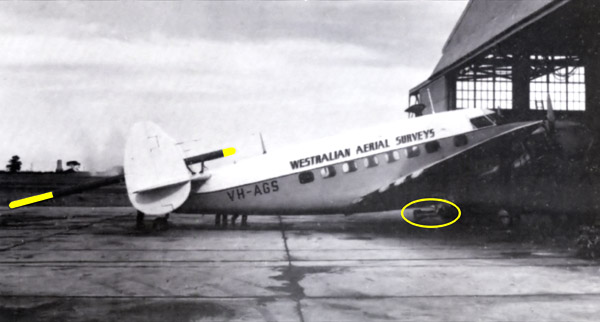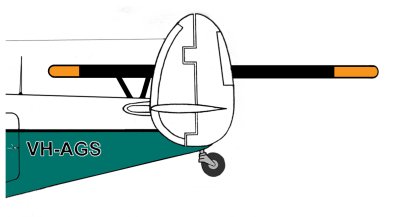|
One
of the lesser known modifications to the Hudson was the fitment
of a magnetometer boom. Adastra's Works Manager, Jack McDonald,
wrote a letter to the Senior
Aircraft Surveyor of the Department of Civil Aviation on 20
March 1962 seeking advice on the installation of a magnetometer
boom on the Hudson. This letter describes the construction of
the boom, which was 16 feet long, but its method of attachment
to the aircraft was still under development. The aircraft file
in the National Archives also includes a page of hand-written
notes on weight and balance
calculations for the boom.
Subsequently, the boom installation was photographed fitted
to VH-AGS (see below). The exact date of this photograph
is unknown, but at the time of the fitment, VH-AGS
was still carrying Westralian Aerial Surveys titles, which it
did until late 1962. It will be noted that VH-AGS
is also carrying a towed bird
installation which is known to have been fitted around May 1962.
This would date the photograph in the latter half of 1962. A
report in the Journal of the Aviation Historical Society of
Australia (Vol 3 No 7, July 1962) states that the boom was painted
"bright red". This may have been so but the photograph
below indicates that at least two colours were applied.

Hudson
VH-AGS with the boom fitted. (Photo: Peter Ricketts)
Although it has been reported that a Hudson never flew with
the boom installation, Ted McKenzie, then Chief Pilot with Adastra,
recalls that he test flew Hudson VH-AGS with the
boom fitted. (Unfortunately, Ted's log books from this period
in 1962 are unavailable):
"There
were several tests of the installation in the latter half of
1962 and I'm pretty sure I was the only one to fly the aircraft
with the boom. The test flying was preceeded by a run along
the east-west runway at Sydney. I was the only one on board
and the idea was to get the tail up and check for any abnormalities
up to take off speed. I remember I was just starting to enjoy
the run to the west when I realised how close the end of the
runway was. I hit the brakes and managed to stop right on the
piano keys. The second test was a full blown air test. As I
recall, I had John Thorpe, Ted Barden and another DCA officer
on board (see below). The aircraft flew normally and we did
quite a bit of turning, pitching and yawing without remarking
any unusual effects. Why it was never pursued I really don't
know, but it could have been difficult to compensate, especially
with a tailwheel aircraft. There was also the question of airspeed
v. response time with the magnetometer of the day but that's
speculation on my part."
In April 2005, the previously unidentified DCA officer from
the 1962 test flight turned up in our Guestbook and identified
himself as John Fincher. John recalls the flight as follows:
"In mid-1962, I was transferred to NSW Region of DCA as
Airworthiness Aircraft Performance Engineer. One of the first
projects I was involved with was a flight test on Hudson VH-AGS
fitted with a magnetometer boom. This was carried out in August
1962. The flight crew consisted of John Thorpe, Ted Barden and
myself representing DCA, and with Ted McKenzie as the pilot.
The flight handling characteristics were virtually unchanged
and the aircraft was 'bounced around' a little to satisfy us
that the boom did not significantly move in flight. To this
end, the floor hatch was removed and a rearward-facing mirror
attached so that someone lying on the floor behind the hatch
could look rearward by the mirror and view the afterpart of
the boom. This task was 'allotted' to my colleague Ted Barden
who, in order to more or less attach himself to the aircraft,
had his feet wrapped around some webbing attached to the rear
bulkhead. I remember after one particularly energetic switchback
manoeuvre there came a large bang from the rear of the aircraft.
I was sitting in the right hand pilot seat next to Ted McKenzie
and remember us both looking at each other in horror as we thought
something had broken. It was however no more than Ted Barden
rising from the floor, hitting the ceiling and then bouncing
back onto the floor again. That was the only flight test that
we carried out at that time on this particular aircraft and
I don't know what became of the installation after that time,
however, the date of August 1962 is correct as my period of
tenure in NSW Region was for twelve months only from July 1962
to July 1963."
THE
HUDSON MAGNETOMETER BOOM - A REPRISE
The following table summarises another series of magnetometer
test flights by Ted McKenzie in Hudson VH-AGE during September
and October 1964. All flights involved magnetometer tests, although
the flights on 26 & 27 September also involved Doppler tests.
Ted is unsure if these flights were with a boom magnetometer
or a towed bird. However, DCA files in the National Archives
of Australia record that Hudson VH-AGE was test-flown
on 2nd October 1964 with a "Boom Support Modification".
The 1962 photo of VH-AGS fitted with the boom confirms that
VH-AGS was fitted with both the boom and a towed bird, so conceivably
VH-AGE could have been tested with both also. On the other hand,
DCA records state that VH-AGE was air-tested on
3 June 1965 with a towed bird, from which it could be inferred
that VH-AGE was not previously fitted with the towed bird system.
This may also date the removal of the boom installation. Ted
McKenzie subsequently flew VH-AGE on an aeromagnetic survey
out of Maralinga in January 1965 at which time the only magnetometer
fitted to the aeroplane was a towed bird.
| Date |
Regn |
Duration |
| 26SEP64 |
VH-AGE |
0:55
|
| 27SEP64 |
VH-AGE |
0:40
|
| 28SEP64 |
VH-AGE |
0:30
|
| 29SEP64 |
VH-AGE |
1:05
|
| 02OCT64 |
VH-AGE |
0:45
|
| 03OCT64 |
VH-AGE |
0:30
|
| 05OCT64 |
VH-AGE |
2:15
|
Why the
magnetometer boom should have been tested on two different Hudsons
two years apart and apparently not used operationally
on either occasion remains a total mystery.
This possible explanation has been provided by Doug Morrison,
a specialist and historian on aeromagnetic survey operations.
"Although those Adastra personnel who could possibly provide
the answer why the magnetometer booms were mounted on Hudsons
in both 1962 and 1964 aren't with us now, it was more than likely
to see whether suitable magnetic data could be obtained. I suspect
it turned out to be very unsuitable and the location probably
made it impossible to compensate for the changes in the magnetic
field from moving aircraft control surfaces (just too much movement
going on near the sensor). It is possible that there may have
been an attempt to get a 'gradiometer' system operational -
such magnetic detection systems were becoming popular in the
late 1960s. The idea was to measure the differences between
the readings of two magnetometers mounted either horizontally
(wingtips) or vertically with one mounted in the stinger and
one towed below in a bird. The difficulty with such systems
was that the sensor closer to the aircraft was generally noisier,
certainly in the 1960s but not so much nowadays with modern
computer controlled active magnetic compensation. Both horizontal
and vertical gradient techniques are still used but it is not
common. Aero Service Corp solved the problem by towing two birds
thus removing the interference from the aircraft although problems
were still encounted if the birds didn't fly properly e.g.,
bird swing (wandering left to right)."
| Issue |
Date |
Remarks |
| 5 |
27MAY21 |
Added
a reference to the boom on VH-AGS having been painted
bright red.
|
| 4 |
28FEB16 |
Added
a possible explanation thanks to Doug Morrison.
|
| 3 |
02APR06 |
Completely
revised with new information from John Fincher and
Ted McKenzie.
|
| 2 |
01OCT04 |
Completely
revised with new information sourced from Ted McKenzie's
log book.
|
| 1 |
28DEC03 |
Original
issue
|
|
![]()

